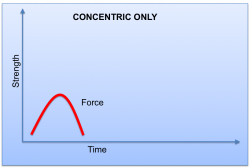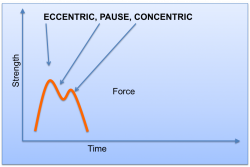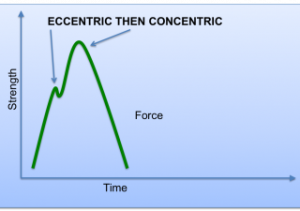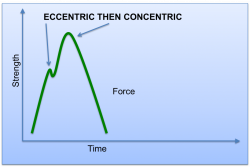Bouncing at the bottom of a rep gives you more power. But why?
It’s due to something called a ‘eccentric-concentric movement pattern’. To understand this, you need a basic knowledge of neuromuscular biomechanics.
A concentric contraction occurs when the muscle fibres are shortening. If you stand with one arm hanging at your side and bend your elbow and bring your hand towards your shoulder, your bicep is performing a concentric contraction. If you then lower it slowly, your bicep is performing an eccentric contraction. The muscle is lengthening, but it is a controlled lengthening. It is effectively ‘breaking’ and slowing the movement.
Most movements involve an eccentric contraction followed rapidly by a concentric contraction. For example.
- Lowering into the bottom of a squat involves the quadriceps, hamstrings and gluteals working eccentrically, while standing back up uses them concentrically.
- Lowering into the bottom of a push-up involves the pecs, deltoids and triceps working eccentrically, while pushing back up uses them concentrically.
- Lowering a bar in a deadlift involves the lower back, gluteals and hamstrings working eccentrically, while lifting back up uses them concentrically.
But how and why does this work?
There are several reasons, but for ease of explanation, the muscle and tendons store energy during an eccentric contraction. This can then be used in the concentric (or lifting) phase. Think of a rubber band being flicked across the room. If you pull back on the rubber band and release it straight away it will fly further than if you pull back on it, pause, then release it. If you’re interested in further reading, research pre-load, muscle potentiation and stretch reflex potentiation as other reasons that eccentric-concentric movement patterns create higher force.
This explains why hand release push-ups (taking your hands off the ground at the bottom of a push-up) are so much harder than the regular kind, and ‘touch and go’ deadlifts are easier than re-gripping every rep.



Time is a big factor here. You lose 50% of the stored energy every second. So if you stop at the bottom of a hand release push-up for one second, you lose half the stored energy. Stopping for four seconds will result in all the stored energy being lost.
Try this. Lower into the bottom of a squat. Hold at the bottom for four seconds, then explode upwards, jumping as high as possible. Now repeat, but explode or ‘bounce’ out of the bottom of the squat, repeating the jump. You should feel a lot more power without the pause. Thank you eccentric-concentric movement pattern.
So how can we use this knowledge to improve performance? By moving quickly from the lower phase to the lifting phase of a movement (the bottom of a squat/dip/push-up/press/pull-up, the back of a backswing in striking sports, the back of a throw in throwing sports, the bottom of a take-off in jumping sports etc) we are able to take advantage of this stored energy to maximise performance. ‘Explode out of the bottom of a rep’ is a good internal dialogue to maximise this effect.





